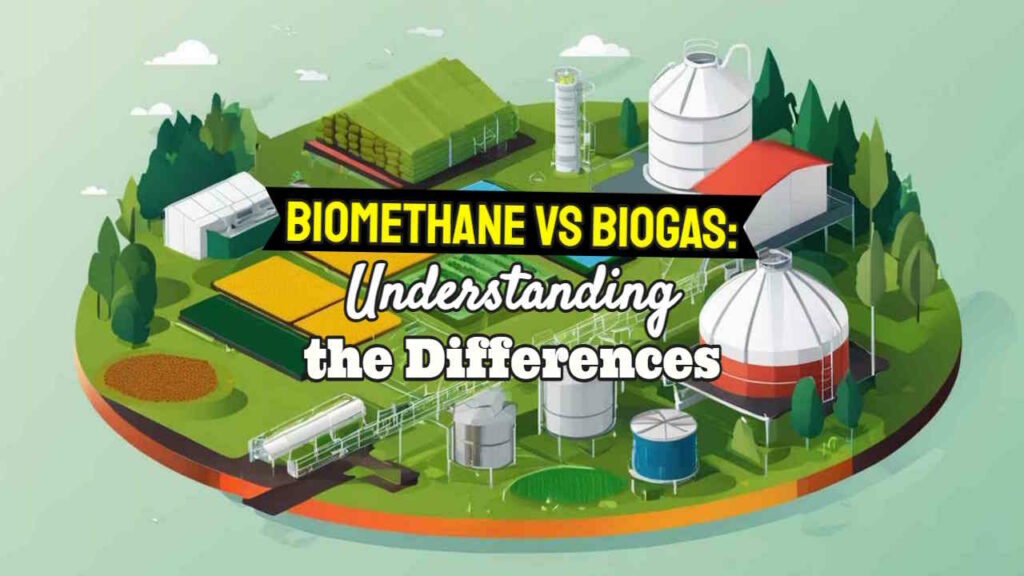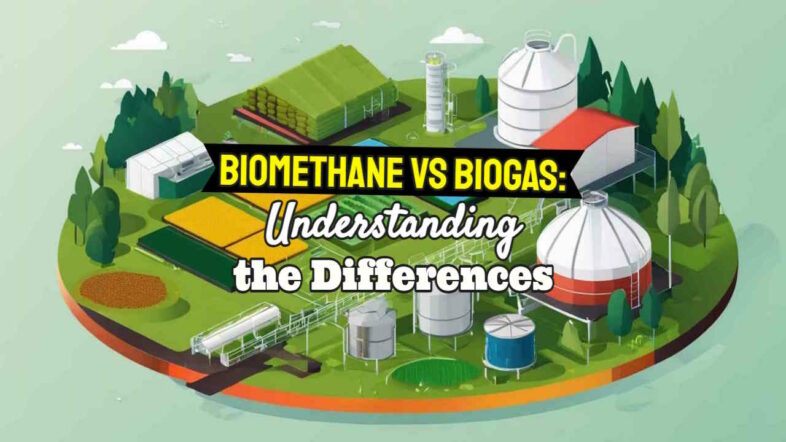A Comparison Between Biomethane vs Biogas: What You Need to Know
In today’s quest for sustainable solutions, the words ‘biogas’ and ‘biomethane’ often buzz around with considerable confusion. As renewable energy sources derived from organic waste rise in importance, understanding these terms becomes essential.
But it is simple, the key fact to remember is:
Biogas is often celebrated as a multi-talented performer in the renewable sector, yet it's biomethane that takes centre stage with its higher methane purity and broader utility. This article demystifies how biogas can become versatile biomethane, a game changer for industries seeking carbon neutrality.
By learning their different roles, we unlock potent strategies against climate change challenges. Read on to discover why swapping natural gas for its greener cousin, biomethane, could be crucial for our planet's future health.
It is not so much that biomethane should be compared with biogas as if they were competing gases when considering biomethane vs biogas. Both have their roles. Both are renewable; one is a raw gas and is a mixture of gases but predominantly methane, whereas biomethane is virtually pure methane.
[boomdevs_toc]
Biomethane vs Biogas: Key Takeaways
- Biogas is a gas mixture produced from organic matter in an oxygen-free environment, containing methane, CO2, and trace gases, while biomethane is the refined form of biogas with a higher methane content after removing CO2 and impurities.
- Biomethane's versatility makes it suitable for use as renewable natural gas in various applications such as transportation, heating, and electricity generation due to its cleaner composition and refining process.
- Understanding the differences between biogas and biomethane enables informed decision-making about their use in renewable heat and power production, clean transport, waste recycling, agroecological transition, and closing the carbon loop for environmental conservation.

The Basics of Biogas and Biomethane
Moving from the opening thoughts, let's look closely at what biogas and biomethane are. Biogas is a mix of gases made without oxygen by breaking down organic matter like food scraps or animal waste.
Anaerobic digestion is the process that does this magic. It's not pure methane but has about 50 to 70 percent of it, with carbon dioxide (CO2) and tiny bits of other gases too.
“🚀Watch this video, the funniest renewable natural gas showdown! Mr. Biogas vs. Mr. Biomethane in a hilarious comedy sketch that had me in stitches. 😂 If you need a good laugh today, this is it! Check it out now and let the giggles begin!
Biomethane comes from cleaning up biogas. This takes out CO2 and other small parts leaving almost entirely pure methane behind; it’s like giving biogas a bath to make it cleaner! Then you get this better fuel, which can replace natural gas because it's so rich in methane—way more than regular biogas—and won't cause corrosion in pipes and equipment.
Biomethane can go into the gas grid or be turned into transport fuel by compression, making it ideal for cutting emissions and using it as clean energy.

Production and Uses of Biogas and Biomethane
Biogas is produced from organic waste in various nations and regions and through different feedstock types, with installed power generation capacity and consumption across industries.
Biomethane, a refined form of biogas, makes up a share of total biogas production and is utilised as renewable energy in various sectors globally.

Biogas production by region and feedstock type
Biogas production varies significantly by region and the type of organic feedstock used. Here is a summary presented in table format to illustrate this variation:
| Region | Predominant Feedstock Types | Biogas Production Notes |
|---|---|---|
| Europe | Energy crops, agricultural waste, sewage sludge, food waste, organic fraction of municipal solid waste (OFMSW). Landfill gas. | Leading in technology for biogas production and use, with significant contributions from Germany and the UK. EU states lead in solid state anaerobic digestion (SSAD) |
| North America | Landfill gas, agricultural waste, and manure. Sewage sludge – some states. | USA and Canada focus on landfill gas recovery and farm-based digesters. |
| Asia | Animal manure, crop residues, industrial waste, Palm Oil production waste (POM) | China and India are major producers, using biogas for rural energy supply. |
| South America | Sugarcane bagasse, livestock manure | Brazil leads with biogas from sugarcane industry by-products. |
| Africa | Animal waste, organic household waste | Biogas projects are growing, with an emphasis on small-scale household systems. |
| Oceania | Agricultural waste, landfill waste | Australia and New Zealand are developing biogas sectors, with a focus on waste-to-energy projects. |
This table of biomethane vs biogas factors highlights the diverse feedstocks and regional approaches to biogas production, reflecting the adaptation to local resources and waste management practices. Moving forward, biogas installed power generation capacity provides insight into how the energy derived from biogas is being integrated into the power grids globally.
Biogas installed power generation capacity
After production, the largely untreated raw biogas is most often used to generate power in reciprocating engines which are hardened to withstand corrosion and silane deposit build-up.
The installed power generation capacity from raw biogas varies by region and feedstock type. It can be harnessed from various organic sources such as agricultural residues, municipal waste, and sewage sludge. This offers a sustainable way to produce electricity, reducing greenhouse gas emissions while utilizing waste materials. The flexibility of biogas also allows it to provide decentralized energy solutions for remote areas, but biogas can be more useful still if upgraded to biomethane.
Biomethane production aligns with the transition towards sustainable fuel sources. With its higher methane content and versatility in applications like transportation and heating, biomethane complements traditional natural gas while reducing reliance on fossil fuels. Its production from biogas enhances the overall efficiency of renewable energy systems due to its cleaner composition and refining process.
Biogas consumption by end-use
With biogas being utilized for power generation, it also finds applications in heating and cooking in small communities and individual households.
Biomethane obtained from the refining of biogas is increasingly used as a renewable substitute for natural gas, enabling its use in various sectors such as transportation, industrial processes, and injection into the natural gas grid.
Furthermore, biomethane's potential to replace fossil fuels in heat and electricity production demonstrates its role in reducing greenhouse gas emissions and promoting sustainable energy practices. This shift towards utilizing biogas and biomethane can significantly contribute to circular waste management, environmental sustainability, and the transition towards cleaner energy sources.
Biomethane production and share of total biogas production
After being produced, biogas can be further refined into biomethane with a higher methane content. Biomethane is a sustainable fuel that results from the purification of biogas. It contains little to no carbon dioxide and other trace gases, making it a valuable renewable natural gas substitute. As for the share of total biogas production rising fastest, biomethane represents an environmentally friendly alternative to fossil fuels. Its increasing production contributes significantly to the renewable energy sector, offering opportunities for clean energy use in various applications such as transportation, heating, and electricity generation.
Global bioenergy consumption by type and sector
Bioenergy consumption globally varies by type and sector. Biomethane, being a versatile fuel for the clean energy transition, is increasingly used as a substitute for natural gas in various applications including heavy goods vehicle (HGV) transportation, heating, and electricity generation.
On the other hand, biogas is commonly utilized for renewable heat and power generation as well as waste recycling. Both biofuels contribute significantly to the agroecological transition and closing of the carbon loop by utilizing organic waste for renewable energy production. It's important to understand these different applications to optimize the benefits of bioenergy.
Next: Differences Between Biogas and Biomethane
Differences Between Biogas and Biomethane
Biogas and biomethane differ in terms of their composition, with biogas being primarily composed of methane and carbon dioxide, while biomethane is almost pure methane.

Definition of biogas and biomethane
Biogas is a mixture of gases produced from organic matter in an oxygen-free environment. It contains methane, CO2, and other gases. Biomethane, on the other hand, is the refined form of biogas with carbon dioxide and trace gases removed.
This results in higher methane content, making it a renewable natural gas substitute. The primary difference lies in their composition – biogas being a mix of various gases including methane and carbon dioxide, while biomethane is predominantly methane-rich.
The production process for both waste-to-energy biofuels involves the recovery of organic waste. Understanding these differences can lead to informed decisions about their use in applications such as transportation, heating, and electricity generation.”.
How biogas and biomethane are produced
Biogas and biomethane are both produced through the anaerobic digestion process that involves the decomposition of organic matter. The production of biogas comes first and is the result of the anaerobic digestion of organic materials, such as agricultural residues, municipal waste, and manure in a controlled oxygen-free environment.
This process results in the production of biogas, which is a gas mixture containing methane, carbon dioxide, and trace amounts of other gases.
Biomethane is produced by purifying (upgrading) that gas mixture to remove carbon dioxide and other impurities, resulting in a higher concentration of methane.
This purification process involves the upgrading or refining of biogas through technologies such as pressure swing adsorption or membrane separation.
The result is a high-purity methane known as biomethane that can be used as a renewable natural gas substitute.
Upgrading biogas into biomethane
To upgrade biogas into biomethane, a process called “biomethanation” is employed. During this process, impurities like carbon dioxide and other trace gases are removed from biogas, resulting in a higher methane content typical of biomethane.
This refined gas can then be used as a sustainable substitute for natural gas in various applications such as heating, electricity generation, and transportation. The upgrading of biogas into biomethane significantly increases its energy efficiency and versatility as a renewable fuel.
This refining process is crucial for making the most out of organic waste recovery by increasing the energy potential of the gas produced. The resultant biomass not only helps in reducing greenhouse gas emissions but also plays an essential role in promoting clean energy transitions across various sectors.
As countries work towards reducing their reliance on fossil fuels, upgrading biogas into biomethane will play an increasingly significant part in achieving sustainable energy goals worldwide. Biomethane is especially valuable because it is the only fully viable renewable heavy goods vehicle power source currently available. Hydrogen powered and battery-electric HGVs will become available soon, but biomethane vehicles are all that is available now!
Benefits and Applications of Biogas and Biomethane
Biogas and biomethane can be used for renewable heat and power, clean transport, waste recycling, agroecological transition, and closing the carbon loop. Read on to learn more about their diverse applications and benefits.
Renewable heat and power
Biomethane is a versatile fuel that can be used for renewable heat and power generation when coupled to a heat exchanger feeding into CHP systems such as district heating. It offers higher energy efficiency than biogas due to its methane-rich composition, making it a valuable substitute for natural gas in all applications.
Also, biomethane production involves removing carbon dioxide and trace gases from biogas, resulting in a cleaner and more sustainable energy source for heating and electricity generation.
Biogas, on the other hand, can on some occasions also be utilized as a biofuel for renewable heat and power supply. Although it contains lower methane content compared to biomethane, biogas still provides an environmentally friendly alternative by utilizing organic waste to produce energy.
Clean transport
Moving on from the use of biomethane in renewable heat and power, it is essential to acknowledge its significant role in clean transport. Biomethane can be used as a sustainable alternative fuel for transportation.
It has been increasingly utilized as a substitute for traditional fossil fuels in vehicles, especially in the public transport sector. With its lower emissions and potential for reducing greenhouse gases, biomethane is a cleaner fuel option for buses, trucks, and even some cars.
The use of biomethane in clean transport aligns with efforts to reduce air pollution and combat climate change. Its production from organic waste not only provides an environmentally friendly energy source but also contributes to efficient waste management practices.
Waste recycling
Waste recycling plays a crucial role in the production of both biogas and biomethane. Organic waste, such as agricultural residues, food waste, and sewage sludge, can be anaerobically digested to produce biogas.
The by-product of this process is digestate, a nutrient-rich material that can be used as organic fertilizer for agriculture.
Furthermore, integrating waste recycling into biogas and biomethane production contributes to reducing greenhouse gas emissions. By diverting organic waste from landfills and utilizing it for bioenergy generation, the release of methane – a potent greenhouse gas produced during the decomposition of organic matter in landfills – is significantly minimized.
Agroecological transition
In the agroecological transition, biogas and biomethane play a crucial role in sustainable farming practices. By utilizing organic waste from agricultural activities, such as crop residues and animal manure, these renewable gases can provide clean energy for on-farm use.
This not only reduces greenhouse gas emissions but also contributes to efficient waste management while promoting self-sufficiency within the agricultural sector. The integration of biogas and biomethane into farming systems supports the circular economy by closing the carbon loop and reducing reliance on non-renewable energy sources.
Moving forward to “Closing the Carbon Loop,” let's explore how these renewable gases contribute to circular economy principles.
Closing the carbon loop biomethane vs biogas
To close the carbon loop, it's crucial to efficiently capture and utilize biogas emissions from organic waste. This can be achieved by employing upgrading or “methanisation” units that convert biogas into biomethane, which when suitably quality assured, is a renewable natural gas substitute.
By integrating biomethane production into waste management systems, we can effectively close the carbon loop and contribute to sustainable energy practices while reducing environmental impact.
By converting biogas into biomethane through upgrading processes such as removing carbon dioxide and trace gases, we not only harness renewable energy but also mitigate harmful methane emissions from organic waste decomposition.
Biomethane vs Biogas – Conclusion
In conclusion, understanding the differences between biomethane and biogas is crucial for promoting renewable energy. These sustainable fuel sources offer practical and efficient solutions for reducing emissions and enhancing the use of renewable energy.
Implementing these strategies can have a significant impact on environmental conservation and lead to the transition to cleaner energy alternatives. For further exploration, readers can delve into additional resources to deepen their understanding of biomethane and biogas.
Let's embrace these renewable energy options to create a greener future for generations to come!
Biomethane vs Biogas FAQs
1. What is the main difference between biomethane vs biogas?
The main difference is that biomethane is a more pure form of energy; it's methane from biogas that has been cleaned up.
2. Can both biogas and biomethane help reduce emissions?
Yes, using either can cut down on harmful greenhouse gases compared to fossil fuels, helping with emissions reduction.
3. How do you make biomethane from biogas?
You upgrade biogas by removing the unwanted bits like carbon dioxide to get biomethane which burns cleanest for energy use.
4. Is all gas made by breaking down waste into methane production usable as fuel?
Not all of it; raw biogas requires upgrading before you can use it widely as clean fuel or turn it into biomethane.





